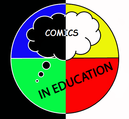LINKS
The following links will be updated regularly. Our goal is to use them to connect you with resources that can be helpful in making your classroom experience with comics and graphic novels the best that it can be. The links page will also feature educational websites that support a fun and exciting approach to K-12 education.
- Literacy Resources for Students: A board with literacy resources for students including graphic novels and highly visual theme-based classroom books from award-winning series like Boldprint and The 10.
- Graphic Novels for Kids: A board with kid-friendly graphic novels specifically designed to help support reluctant and struggling readers.
- The Best Graphic Novels of All Time: This board will give you a wealth of comics and graphic novels you can read in advance of teaching that first unit on visual narrative. Read these and consider yourself up-to-date on the classics of sequential art.
Blogs and other Sites
- The Graphic Classroom: This site is a resource for teachers and librarians to help ensure that they are accessing high-quality, kid-friendly comics and graphic novels for the classroom.
- Where Gay and Lesbian Comic Book Characters Live: This is a great resource for teachers wanting to examine LGBTQ issues through the medium of visual narrative, and provides lists of characters from comics and graphic novels who are gay, lesbian, bisexual, transgendered, or whose sexual identity is uncertain.
Museums
- ToonSeum: One of only a handful of museums in the world dedicated to comics and cartooning. Here is their mission statement: "The mission of the ToonSeum is to celebrate the art of cartooning. Our goal is to promote a deeper appreciation of the cartoonists and their work through hands-on workshops, community outreach, cartoon-oriented educational programming, and exhibitions of original cartoon art."
- The Cartoon Art Museum: Located in San Francisco, The Cartoon Art Museum’s mission is "to preserve, document, and exhibit this unique and accessible art form. Through traveling exhibitions and other exhibit-related activities — such as artists-in-residence, lectures, and outreach — the museum has taken cartoon art and used it to communicate cultural diversity in the community, as well as the importance of self-expression.





